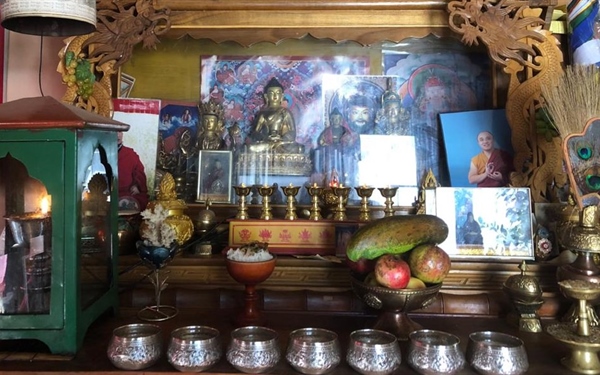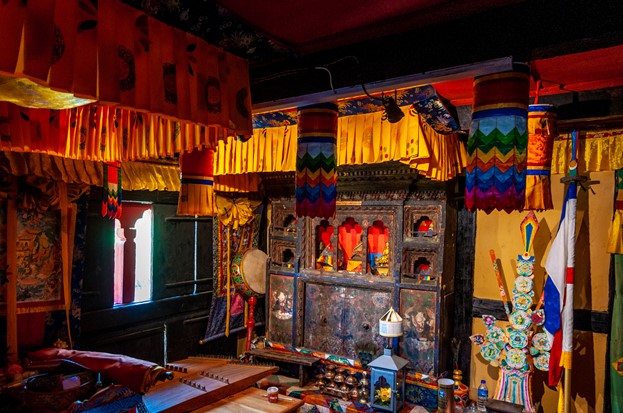The significance of offering seven bowls of water
The 7 bowls signify respectively: water for drinking, water for washing, flowers, incense, light, perfume, and food.

For the people of Bhutan who are devout Buddhist, yonchap is a way of life.
Yonchap is the practice of making an offering out of water, as water is one of the four elements of nature. The worshipper approaches with a desire for generosity, and to reign in their selfishness and greed.
Water is considered free, plentiful, and painless to give. The message is that we should offer all of our offerings the way we would offer water.
The practice has been a part of Himalayan Buddhist tradition since the 8th century, but it only became more widespread in the 11th century when the Indian master Atisa visited Tibet. He noticed the Tibetan springs and rivers to be very clean. Thus he proposed that water alone was enough as an offering in the Himalayas. With that, yonchap became even more common.
The practice of yonchap
When practicing yonchap, the water should be the purest possible. Therefore, Bhutanese usually collect water from the springs as the rivers might have been polluted by animals.
Water is generally retrieved early in the morning while it is still fresh and clean. If it is the rainy season or the water is muddy, it is left to sit until the impurity settles at the bottom. Ideally, the water used for yonchap should have eight qualities: cool, delicious, light, soft, clear, odourless, soothing to the throat, and gentle on the stomach.
The significance of each bowl
The usual practice is to set up seven bowls.
Some sources say that seven bowls are used to achieve the seven limbs (or aspects) of enlightenment. It represents the seven elements of prayer:
- Prostrating
- Offerings to the Buddhas
- Confessing our wrongs
- Rejoicing in the good qualities of oneself and others
- Requesting for the Buddhas to remain in the world
- Beseeching the Buddhas to teach others
- Dedicating the merits of ourselves and others so that all sentient beings may enjoy happiness and virtue
Each of the seven bowls has its unique significance. The seven bowls consist of two waters and five items of basic utility. They are as follows
- The first bowl
For the Buddha to drink and cleanse his mouth or face.
- The second bowl
For the Buddha to wash his feet or take a bath. It symbolises purification of our negative karma.
- The third bowl
Represents the different types of flowers. Symbolises the beauty and flowering of enlightenment, signifying the opening of one’s heart.
- The fourth bowl
Represents incense to produce a sweet-smelling aroma for the Buddha. Symbolises morality, ethics, and discipline.
- The fifth bowl
Comes with a source of light, usually a lamp, to illuminate darkness. The light symbolises the dispellation of all darkness of the mind and ignorance. Ignorance refers to one being unaware of their true inherent Buddha Nature.
- The sixth bowl
It is scented. The perfume symbolises perseverance and joy, which is the heart of enlightenment.
- The seventh bowl
This is food. Although the enlightened one does not require material food offerings, it is for the temporary relief from suffering that beings experience through hunger and starvation.
- The eighth bowl
If eight bowls are offered, the eighth bowl has an offering that represents sound, perhaps a musical instrument, to entertain God with music.
Setting up the seven bowls
The Bhutanese have a technique for setting up the bowls at a shrine. The bowls must:
- Be in a straight line so that one will have an honest personality.
- Have uniform gaps between them, each the distance of a barley grain. Too far and the worshipper will never meet their spiritual teacher, too close and their minds become dull.
- Not be overfilled or underfilled; fill up to the brim, leaving the space of a barley. Underfilling it will lead to impoverishment whereas overfilling leads to excessiveness

As the worshipper pours, they visualise the water being purified and think, “When I offer the water, may all sentient beings be free from thirst, everyone be quenched, and let no one suffer from thirst.” It is a meditative spiritual practice.
Usually, the Bhutanese put out water offerings every morning, or as often as they can. Some practice it in the evening too.
First, they take seven clean bowls of any material, usually copper, brass, silver, porcelain, or glass.
They fill a jug with clean water. As they pour, they chant the seed syllabus of Buddha’s body, speech, and mind to purify the water: Om ah hum.
Next, they fill the bowls and then place them on the shrine from left to right. They never put an empty bowl on the altar.
At the end of the day or the next day before new offerings, the worshipper removes the bowls one by one from right to left. They dry each bowl and place it face down on the shrine or put it away.
The water might be thrown away, but some use it on houseplants or the earth to share the offerings.
Last but not least, they dedicate the merit gained from the offering to free all sentient beings from thirst and other forms of suffering. The dedication is very important because making an offering without the dedication is of no benefit.





